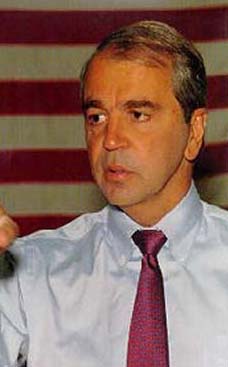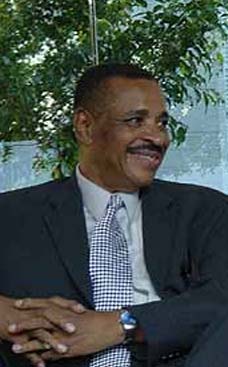
In the summer of 2004, amateur paleontologists Mike Kelly and Greg Kovalchuk made such a proverbial needle-in-the-hay-stack kind of discovery on public lands in the grey hills of central Oregon. While looking for fossil sea shells (known as invertebrate fossils), Kelly noted a rock with an odd shape in it. That odd shape turned out to be an inch-long tooth. Closer examination revealed more teeth scattered down the slope. They realized that those teeth belonged to a creature with a backbone, a vertebrate fossil. Both Kelly and Kovalchuk knew then they had made an important discovery. They also knew that collecting vertebrate fossils off public land was not allowed and was, in fact, illegal. So, what to do?
RPCVs Greg Kovalchuk and Mike Kelly Find Rare Fossil
Amateur Paleontologists Find Rare Fossil
Caption: Dr. James E. Martin works carefully to remove rock from a portion of the plesiosaur fossil as co-disconverers Greg Kovalchuk and Mike Kelly look on. Photo: John Craig
PRINEVILLE, OR- Imagine an ancient marine reptile with a very large seal-like body, a long tail and an extended head and neck. The head is rather long and sleek, like an alligator, with sharp, pointed teeth. The reptile has a thick abdomen and flat, elongated limbs that serve as powerful paddles for moving through the ocean that once covered most of Oregon 90 to 100 million years ago. Now, imagine you are out for a day hike and you stumble upon the skeletal remains of such an animal. You may not be sure of what you have found, but you have a feeling it is something special. And special, it is…..
In the summer of 2004, amateur paleontologists Mike Kelly and Greg Kovalchuk made such a proverbial needle-in-the-hay-stack kind of discovery on public lands in the grey hills of central Oregon. While looking for fossil sea shells (known as invertebrate fossils), Kelly noted a rock with an odd shape in it. That odd shape turned out to be an inch-long tooth. Closer examination revealed more teeth scattered down the slope. They realized that those teeth belonged to a creature with a backbone, a vertebrate fossil. Both Kelly and Kovalchuk knew then they had made an important discovery. They also knew that collecting vertebrate fossils off public land was not allowed and was, in fact, illegal. So, what to do?
Fortunately, Kelly and Kovalchuk knew exactly what to do. They noted the location of the find with their Global Positioning System (GPS) and left the site undisturbed. Later, Kelly and Kovalchuk contacted John Zancanella, Paleontology Program Coordinator for the Bureau of Land Management (BLM) in Oregon and Washington. They made arrangements to meet in the field to confirm the discovery. Once verified, the BLM acquired the services of paleontologist Dr. James E. Martin, Curator of Vertebrate Paleontology of the Museum of Geology, South Dakota School of Mines and Technology, to help recover the specimen.
Dr. Martin, one of the leading experts on marine reptile fossils, has spent many years in Oregon looking for and studying a diverse array of fossils.
"I never expected to see such a specimen from Oregon in my lifetime! This is an extremely exciting and important fossil discovery," said Dr. Martin.
The specimen discovered by Kelly and Kovalchuk turned out to be a lower jaw of a plesiosaur, a marine reptile that swam in the ocean that covered most of Oregon 90 to 100 million years ago during the Cretaceous. Pleisosaurs were primarily fish eaters and grew to a length of about 25 feet. The three-foot long lower jaw represents the third vertebrate specimen fossil found from the end of the Age of Reptiles in the Pacific Northwest, the other two fossil fragments having been discovered 85 years ago. The fossil is the first plesiosaur from the area and appears to represent a group that was worldwide in distribution during the end of the Age of Reptiles.
The recovered specimen will be housed at the Museum of Geology in South Dakota. The museum staff is currently removing the rock from the fossil to determine the specimen’s condition. The BLM is working with local entities to find a more permanent home for a replica for public education purposes.
"Kelly and Kovalchuk did everything right! Without their exemplary actions – finding the specimen, recognizing its importance, leaving it in place and intact and contacting the right people – we wouldn’t have this story to tell. Their responsible actions have advanced the science of paleontology and made it possible to share this unique discovery with the rest of the public," said Zancanella.
Zancanella is hopeful that this story will encourage others who find fossils or cultural artifacts on public lands to follow their good example and report the find to the appropriate land management agency.
The BLM, an agency of the U.S. Department of the Interior, manages more land-261 million surface acres-than any other Federal agency. Most of this public land is located in 12 Western States, including Alaska. The Bureau, with a budget of about $1.9 billion, also administers 700 million acres of sub-surface mineral estate throughout the nation. The BLM’s multiple-use mission is to sustain the health and productivity of the public lands for the use and enjoyment of present and future generations. The Bureau accomplishes this by managing such activities as outdoor recreation, livestock grazing, mineral development, and energy production, and by conserving natural, historical, cultural, and other resources on the public lands.











